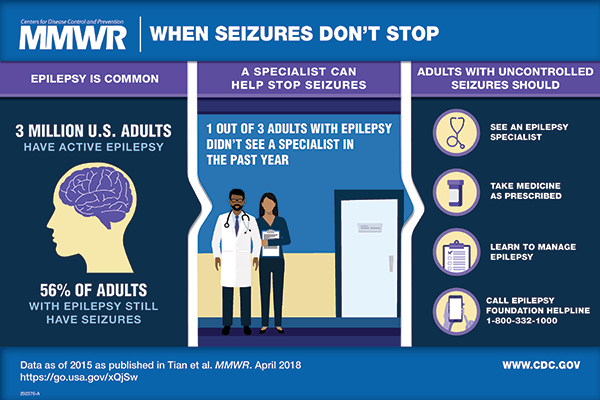The Latest Stats about Epilepsy from the CDC: Who has epilepsy and seizure control?

Epilepsy News From: Tuesday, April 24, 2018
Community Corner
About the Project
One of the most important activities from the Centers for Disease Control and Prevention (CDC) is to collect information about health conditions, who and how many are affected, and other data that can help groups like the Epilepsy Foundation know how to help.
Last week, the CDC published new information about epilepsy and seizure control that sheds light on whether enough progress is being made in helping people with epilepsy get appropriate care.
Using the National Health Interview Survey (NHIS), a random sample of adults in the U.S. during 2013 and 2015 were surveyed about their epilepsy and other issues.
Questions specific to epilepsy included:
- Having active epilepsy – defined as being diagnosed by a doctor or taking a seizure medication or having at least one seizure in the past year
- Having seen a neurologist or epilepsy specialist (called epileptologist) in the past year
- Taking seizure medication
- Had no seizures in the past year (indicates level of seizure control)
What were the results?
Higher numbers of people reported active epilepsy in 2015 than in 2010.
- 1.2% of the U.S. population or 3 million adults have active epilepsy in 2015. If you add children, the number reaches 3.4 million each year.
- This has increased from 2.3 million adults with active epilepsy in 2010.
- The numbers of people with epilepsy differed by race, marital status, education, income, and employment.
Only 2 out of 3 adults with active epilepsy were seeing a neurologist or epilepsy specialist.
- The likelihood of seeing this type of specialist differed by age, education, and where people lived.
- The survey was not able to capture information about whether the provider was an epileptologist or from a comprehensive epilepsy center.
Taking seizure medicine
- 90% of adults with active epilepsy took seizure medicines.
- Only 44% of people taking seizure medicines reported no seizures in the past year. This means 56% were still having seizures despite seizure medicine.
- Seizure control was better in older adults, people with more social supports, and those with higher household income.
- More people (95%) took seizure medicine if they saw a neurologist or epilepsy specialist, but no changes in the numbers of people with seizure control were seen.
What does this mean?
- At least 3 million adults in the U.S. have active epilepsy, and the numbers have increased from 2010, when they're tracked through this type of survey.
- More people have uncontrolled epilepsy than we thought.
- Typically, the epilepsy community reports that 70% of people with epilepsy can get seizures controlled with seizure medicine, but different ways of collecting information have been used.
- The CDC information focuses on people with active epilepsy and comes from people in the community, not just from clinics or hospital-based data.
- Keep in mind that the data from the CDC does not currently include children with epilepsy or people with a history of epilepsy (inactive epilepsy).
- This study shows that less than half or 44% of adults with epilepsy can get seizures controlled with medicine.
- This data stresses a major point – There still is much to do to help the 56% of adults who have uncontrolled seizures!
- When treating people with seizures, note the social factors that may affect their health. Little social support, low levels of income and education, unemployment, where people live, and people's lifestyles may affect their epilepsy and ability to control seizures.
What can I do?
Data like this should encourage each and every one of us to speak up and be our own advocate.
- If you have epilepsy or are a loved one of someone with epilepsy, make sure your health care team knows how you are doing.
- If you are still having seizures, tell them! Don’t settle for continued seizures, even if it’s just 1 or 2 a year.
- See an epilepsy specialist, ideally at a comprehensive epilepsy center.
- Make sure you explore all treatment options. Talk with your team about whether new and add-on medications, dietary therapy, neurostimulation devices, surgery, or a clinical trial might help you. Not everyone will get complete seizure control, but you never know unless you see the right people and try.
- There is more to managing your seizures than seeing a doctor. If you still have seizures, take at least these steps.
- Make sure you know how to take your seizure medicines and what to do if you miss any. If the pill schedule is too complicated, ask for help.
- Know your triggers. If your lifestyle, stress, or certain situations make you more likely to have seizures, learn what you can do to modify your lifestyle. This can help improve seizure control in many people.
- Reach out for help. Contact your local Epilepsy Foundation, connect with others online, or call the Epilepsy Foundation 24/7 Helpline at 800-332-1000 (en Español 1-866-748-8008).
- Take steps to improve your overall wellness, including healthy living and independent living factors for you and your loved ones.
- Learn about programs offered by the Epilepsy Foundation and other groups to help you manage your epilepsy.
- CDC sponsored programs from the Managing Epilepsy Well (MEW) Network are offered by many local Epilepsy Foundations.
Special thanks to the CDC Epilepsy Program for sharing this information with us. We will continue to dig into the study to learn more and share resources to help.
And remember, speak up and be active in your care!
Best wishes,
Patty Osborne Shafer RN, MN
Authored by
Patty Obsorne Shafer RN, MN
Reviewed by
Joseph I. Sirven MD
Reviewed Date
Tuesday, April 24, 2018
